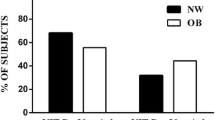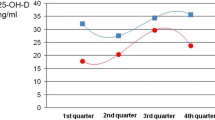Abstract
Purpose
To assess vitamin D status in children aged 2–220 months in northeastern Italy (latitude 46°). Serum 25-hydroxyvitamin D (25OHD) concentration was assessed in 93 children afferent to the Pediatric Department of the Hospital of Udine.
Methods
Vitamin D status was defined as follows: sufficient with serum 25OHD between 50 and 250 nmol/l (level 4); insufficient between 37.5 and 50 nmol/l (level 3); deficient less than 37.5 nmol/l (level 2); severely deficient if less than 12.5 nmol/l (level 1). We investigated the potential risk factors of vitamin D deficit.
Results
We found that six children (6.4%) had level 1, 36 (38.7%) had level 2, 9 (9.7%) had level 3, and only 45.2% had sufficient level of 25OHD. Immigrate children had a higher risk for vitamin D deficiency if compared with Italians: 75% of non-Italian children had an insufficient 25OHD level compared with 47.0% of Italian children (p = 0.0036). There was a marked seasonal effect on 25OHD level: when plasma sample was withdrawn between November and May, only 29.4% of children showed sufficient vitamin D level, while 70.5% was insufficient (p < 0.0001). Among the obese children, 9.0% had sufficient level of 25OHD with 90% being deficient (p = 0.01). We did not find any significant difference in vitamin D status among children in different age groups.
Conclusion
Vitamin D deficiency is common in children living in northeastern Italy. The risk factors were winter season for blood withdrawal, non-Caucasian race, and obesity. These high-risk groups should be targeted for screening and educated about the need of sunlight exposure.

Similar content being viewed by others
References
Misra M, Pacaud D, Petryk A, Collett-Solberg PF, Kappy M (2008) Drug and Therapeutics Committee of the Lawson Wilkins Pediatric Endocrine Society. Vitamin D deficiency in children and its management: review of current knowledge and recommendations. Pediatrics 122(2):398–417
Gartner LM, Greer FR (2003) Section on Breastfeeding and Committee on Nutrition. American Academy of Pediatrics. Prevention of rickets and vitamin D deficiency: new guidelines for vitamin D intake. Pediatrics 111(4 Pt 1):908–910
Wagner CL, Greer FR (2008) American Academy of Pediatrics Section on Breastfeeding; American Academy of Pediatrics Committee on Nutrition. Prevention of rickets and vitamin D deficiency in infants, children, and adolescents. Pediatrics 122(5):1142–1152
Canadian Paediatric Society Position Statement (2002) Vitamin D supplementation in northern native communities. Paediatr Child Health 7(7):459–472 (English, French)
Rovner AJ, O’Brien KO (2008) Hypovitaminosis D among healthy children in the United States: a review of the current evidence. Arch Pediatr Adolesc Med 162(6):513–519
Cheng S, Tylavsky F, Kröger H, Kärkkäinen M, Lyytikäinen A, Koistinen A, Mahonen A, Alen M, Halleen J, Väänänen K, Lamberg-Allardt C (2003) Association of low 25-hydroxyvitamin D concentrations with elevated parathyroid hormone concentrations and low cortical bone density in early pubertal and prepubertal Finnish girls. Am J Clin Nutr 78(3):485–492
Lehtonen-Veromaa M, Möttönen T, Irjala K, Kärkkäinen M, Lamberg-Allardt C, Hakola P, Viikari J (1999) Vitamin D intake is low and hypovitaminosis D common in healthy 9- to 15-year-old Finnish girls. Eur J Clin Nutr 53(9):746–751
Heaney RP (1999) Lessons for nutritional science from vitamin D. Am J Clin Nutr 69(5):825–826
Lippi G, Montagnana M, Targher G (2007) Vitamin D deficiency among Italian children. CMAJ 177(12):1529–1530 author reply 1530
Wallace AM, Gibson S, De La Hunty A, Lamberg-Allardt C, Ashwell M (2010) Measurement of 25-hydroxyvitamin D in the clinical laboratory: current procedures, performance characteristics and limitations. Steroids 75:477–488
Kumar J, Muntner P, Kaskel FJ, Hailpern SM, Melamed ML (2009) Prevalence and associations of 25-hydroxyvitamin D deficiency in US children: NHANES 2001–2004. Pediatrics 124(3):e362–e370 [Epub 2009 Aug 3]
Kreiter SR, Schwartz RP, Kirkman HN Jr, Charlton PA, Calikoglu AS, Davenport ML (2000) Nutritional rickets in African American breast-fed infants. J Pediatr 137(2):153–157
Callaghan AL, Moy RJ, Booth IW, Debelle G, Shaw NJ (2006) Incidence of symptomatic vitamin D deficiency. Arch Dis Child 91(7):606–607 [Epub 2006 Apr 4]
Specker BL, Valanis B, Hertzberg V, Edwards N, Tsang RC (1985) Sunshine exposure and serum 25-hydroxyvitamin D concentrations in exclusively breast-fed infants. J Pediatr 107(3):372–376
Gessner BD, Plotnik J, Muth PT (2003) 25-Hydroxyvitamin D levels among healthy children in Alaska. J Pediatr 143(4):434–437
Markestad T (1983) Effect of season and vitamin D supplementation on plasma concentrations of 25-hydroxyvitamin D in Norwegian infants. Acta Paediatr Scand 72(6):817–821
El Hayek J, Egeland G, Weiler H (2010) Vitamin D status of Inuit preschoolers reflects season and vitamin D intake. J Nutr 140(10):1839–1845 [Epub 2010 Aug 11]
Huotari A, Herzig KH (2008) Vitamin D and living in northern latitudes—an endemic risk area for vitamin D deficiency. Int J Circumpolar Health 67(2–3):164–178
Holick MF (2004) Sunlight and vitamin D for bone health and prevention of autoimmune diseases, cancers, and cardiovascular disease. Am J Clin Nutr 80(6 Suppl):1678S–1688S
Wharton B, Bishop N (2003) Rickets. Lancet 362(9393):1389–1400
Carvalho NF, Kenney RD, Carrington PH, Hall DE (2001) Severe nutritional deficiencies in toddlers resulting from health food milk alternatives. Pediatrics 107(4):E46
Edidin DV, Levitsky LL, Schey W, Dumbovic N, Campos A (1980) Resurgence of nutritional rickets associated with breast-feeding and special dietary practices. Pediatrics 65(2):232–235
Kalkwarf HJ, Khoury JC, Lanphear BP (2003) Milk intake during childhood and adolescence, adult bone density, and osteoporotic fractures in US women. Am J Clin Nutr 77(1):257–265
Banca Dati di Composizione degli Alimenti per Studi Epidemiologici in Italia a cura di Gnagnarella P, Salvini S, Parpinel M. Versione 1.2008. http://www.ieo.it/bda
Gordon CM, DePeter KC, Feldman HA, Grace E, Emans SJ (2004) Prevalence of vitamin D deficiency among healthy adolescents. Arch Pediatr Adolesc Med 158(6):531–537
Wortsman J, Matsuoka LY, Chen TC, Lu Z, Holick MF (2000) Decreased bioavailability of vitamin D in obesity. Am J Clin Nutr 72(3):690–693
Harkness L, Cromer B (2005) Low levels of 25-hydroxy vitamin D are associated with elevated parathyroid hormone in healthy adolescent females. Osteoporos Int 16(1):109–113 [Epub 2004 Jun 2]
Docio S, Riancho JA, Pérez A, Olmos JM, Amado JA, González-Macías J (1998) Seasonal deficiency of vitamin D in children: a potential target for osteoporosis-preventing strategies? J Bone Miner Res 13(4):544–548
Author information
Authors and Affiliations
Corresponding author
Rights and permissions
About this article
Cite this article
Marrone, G., Rosso, I., Moretti, R. et al. Is vitamin D status known among children living in Northern Italy?. Eur J Nutr 51, 143–149 (2012). https://doi.org/10.1007/s00394-011-0200-9
Received:
Accepted:
Published:
Issue Date:
DOI: https://doi.org/10.1007/s00394-011-0200-9




